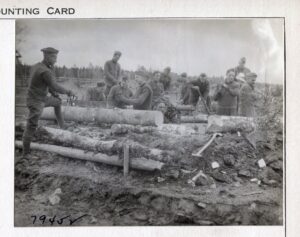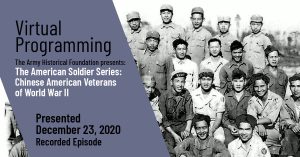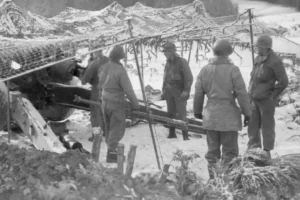By Joshua Cline
“We Remained” were the words proudly declared by then-Major Russell Volckmann’s command. When the Japanese invaded the Philippines in December 1941, Volckmann and his men fought back, and when Bataan fell, Volckmann and a handful of others refused to surrender and escaped the Bataan Death March. When American forces returned to Luzon in 1945, Volckmann’s guerrillas unleashed hell on the occupying Japanese. “We Remained” was a proud and defiant proclamation to match General Douglas MacArthur’s “I Shall Return.”

Brigadier General Russell W. Volckmann was a visionary leader in asymmetric warfare and guerilla tactics. Aside from conducting a highly successful guerrilla campaign against Japanese forces, Volckmann pioneered the use of forward air controllers, was key in founding Army Special Forces, and wrote manuals and doctrine based on his experiences that are largely still in use today.
Volckmann was born on 23 October 1911 in Clinton, Iowa. In 1917, at the age of six, he became the unofficial mascot of Company C, 133d Infantry Regiment, Iowa National Guard. In 1930, he entered West Point with the Class of 1934, graduating 189th of 250. Volckmann volunteered for the Philippines, but his low class standing saw him assigned as a platoon leader and company executive officer in the 3d Infantry Regiment at Fort Snelling, Minnesota. Promoted to captain in 1937 and assigned to Fort Sam Houston, Texas, Volckmann then served with the 2d Division. In 1940, Volckmann wrote a letter to the Chief Adjutant General in Washington, DC, asking for reassignment to the Philippines, calling attention to the fact his name had been on the volunteer list for six years. A week later Volckmann set out for the U.S. Armed Forces in the Far East (USAFFE).
Volckmann’s first assignment in the Philippines was command of Company H, 31st Infantry Regiment, in the summer of 1940. In late August 1941, he became senior instructor of the 11th Infantry, 11th Division (Philippine Army, PA), in Baguio, Luzon. Captain Volckmann also acted as the 11th’s executive officer under Colonel Glen R. Townsend. “By the middle of 1941…even I became aware that war was but a question of time,” Volckmann wrote. The same month he was reassigned, USAFFE dependents were evacuated. Volckmann’s wife and son would not see him again until late 1945.
Most of his new troops spoke no English, and many had trouble understanding each other, as there were a total of eleven different dialects within the unit. Officers and men alike had “practically no knowledge of fundamental and basic techniques” when the unit was formed. Equipped with Enfield rifles of World War I vintage and four Browning Automatic Rifles per rifle company, Volckmann noted the regiment had “less than the firepower of one U.S. combat battalion.” He found interpreters and did his best to train the 1,850 man unit.
When war broke out on 8 December 1941, the 11th Infantry moved to a five-mile stretch along the Lingayen Gulf. On 10 December, the Japanese Fourteenth Army landed at Aparri and Vigan, the latter fifty miles from Volckmann’s forces. Colonel Townsend was soon reassigned and command of the whole regiment fell on Volckmann. The 11th withdrew on 24 December and headed towards Bataan. The 11th Division was cut off by the Japanese on 27 December, forcing the men to leave behind any equipment that could not be carried. Spying a single railway track, Volckmann commandeered a steam engine with seven cars. The regiment then withdrew in the darkness aboard the train. While the 11th Infantry escaped wholly intact, the rest of the division was mauled.
The regiment’s first brush with danger came before dawn on 29 December. By then, most of Volckmann’s men were without shoes and many were without serviceable rifles. Furthermore, the division had no artillery. The 11th Infantry was ordered to “hold a line north of the La Paz-Carmen-Zaragoza road until you are licked.” Nearby was the 91st Division (PA), to which Volckmann’s third battalion was detached.
Volckmann woke up to 3d Battalion fighting alone against a Japanese onslaught. The 91st Division had withdrawn during the night. Even worse, tanks and engineers under independent command destroyed a critical bridge, leaving the regiment with only one escape route. When the tanks wholly retreated from the fight, an officer wrote, “[The 11th Infantry] thought the engagement was lost…Our regimental commander, fortunately, was at the scene and coolly proceeded to organize a counterattack.” The regiment withdrew in good order under cover of darkness, albeit with heavy casualties.
On 4 January 1942, the 11th Infantry reached Bataan. On 25 January, the entire 11th Division was moved to the line of defense near Pilar-Bagac. Volckmann was promoted to major on 31 January 1942. On 1 April, Major Volckmann was made division intelligence officer. Here, Volckmann learned that units that had been unable to escape the Japanese in North Luzon had regrouped in the city of Baguio under Colonel John P. Horan’s command. However, with the area occupied by the Japanese and escape being nearly impossible, Horan had ordered the units dispersed. “As a result of this order,” Volckmann wrote, “sparks of resistance spread to every corner of North Luzon, and from these sparks a flame sprang that burned throughout the dark days of the Japanese occupation.” There were four regiments worth of men still in the area, and Volckmann judged the North Luzon mountains as ideal terrain for covert warfare, with an armed and American-supporting populace.
As Bataan fell on 9 April and the 11th Division commander, Major General William Brougher, prepared to show the white flag, Volckmann proposed his plan. Brougher responded, “I’ll report you missing in action on a patrol…Best of luck to you.” Only one other officer was willing to go, the rest were later subjected to the Bataan Death March. Together, Volckmann and Captain Donald D. Blackburn crawled for hours to avoid detection during the official surrender. Blackburn would serve Volckmann as a trusted lieutenant for the remainder of the war.
From Bataan, Volckmann and Blackburn set off on a 130-mile trek to Benguet in the North Luzon mountains, avoiding well-traveled routes and populated areas. Bouts of tropical diseases like malaria, beriberi, and dysentery would debilitate the men. Only the actions of courageous civilians along the route kept the two soldiers alive. Volckmann and Blackburn reached North Luzon on 9 September, exactly five months after escaping Bataan.
Volckmann joined Lieutenant Colonels Martin Moses and Arthur Noble, leaders of resistance movements that he had learned of through the “bamboo telegraph,” messages passed from village to village. A guerrilla campaign launched on 15 October 1942 failed in every measure. Poor communications were partially responsible for the failure, and in the pursuit of improving them, Volckmann began to request food from locals, promising full compensation at the end of the war from the United States on his own authority.
On 9 November, the Japanese began a counteroffensive that obliterated all progress Volckmann and other guerrillas had made. Volckmann later wrote, “…[from mountainsides] we could see numerous native villages going up in smoke.” Units were dispersed, the communications systems were disrupted, and it was impossible to fight back. Volckmann’s superiors did not issue any orders after the Japanese operation began, resulting in Volckmann often working on his own initiative. He trained new guerrilla cadres, raising forces for future conflict and ending long-term tension and conflict between several tribes. He also recruited ex-Philippine Army and Philippine Scouts of Horan’s disbanded regiments, plus hunters, trappers, and escaped Americans.
By April 1943, Volckmann had a communication network with regular contact to other USAFFE resistance groups in Ifugao and Bontoc sub-provinces. However, on 1 June, outside of Lubuagan, Kalinga, Moses and Noble were captured by the Japanese. Major Volckmann was now the highest-ranking officer remaining in North Luzon and responsibility fell squarely on steady shoulders. He spent the summer planning, and his sweeping changes began in August. He reorganized the Northern Luzon guerilla units, instituting a central command structure and reviving the regimental commands Horan had disbanded.
Volckmann’s area of operations covered 15,000 square miles. North Luzon was divided into districts controlled by five regiments: the 11th, 14th, 15th, 121st, and 66th Infantry (the latter created from units that had all been cut off when their parent units retreated to Bataan). To command them, Volckmann established a general headquarters under his leadership. He also created a new designation: United States Armed Forces in the Philippines-North Luzon (USAFIP-NL).

Filipino support was critical in every single part of Volckmann’s operation. The vast majority of Volckmann’s men were Philippine Army or Scouts or native tribesmen. The scattered units were connected through a reliable array of communications and intelligence networks. Civilians provided food, water, and intelligence while risking brutal reprisals for assisting the guerrillas.
Volckmann had learned from predecessors that his guerrillas had to be a preferable alternative to the Japanese. Consequently, he tried to minimize collateral damage. At the same time, Volckmann had to contend with a “fifth column.” Spies and informants, when caught, were executed. He allowed his irregulars to deal with collaborators however they saw fit, which was perhaps a misstep. Though Volckmann never personally conducted atrocities, men under his command did so in the name of eliminating collaborators. At least one American in command of a regiment was relieved of command by Volckmann for burning an entire village. Postwar, Philippine President Manuel Roxas exonerated the actions of USAFIP-NL.
By summer 1944, Volckmann faced a looming supply crisis. To solve it, maintain Filipino support for his forces, and effect a larger part in the war, Volckmann wanted radio contact with MacArthur. His excellent intelligence-gathering capability could make a difference in a landing on Luzon. Volckmann’s initial broadcast in September was the first message of any American force in North Luzon since March 1943, when guerrilla Major Ralph Praeger had been captured and later executed.
On 29 August, Volckmann transmitted the orders given to his guerrillas, which they pursued until American landfall and beyond. They were to harass and destroy all lines of communication; hamper troop movements; destroy supply dumps; and prevent the Japanese from stealing from the Filipino populace. With the Japanese outnumbering him at a minimum of seven to one, ensuring the forces of General Tomiyuki Yamashita, commander in the Philippines, did not have adequate ammunition, food, or supplies was the main intent.
On 20 October, General MacArthur landed on Leyte, 400 miles to the south of Luzon. On 20 November, Volckmann was promoted to the temporary rank of lieutenant colonel. On 30 November, the 14th Infantry in the Fifth District recovered a treasure trove of intelligence from a crashed Japanese liaison plane in Nueva Vizcaya. From this it was determined Yamashita had relocated to Baguio and moved his six divisions into the same mountains that Volckmann’s men knew every inch of.

Four boats landed supplies before Allied forces reached Luzon. The third on 12 December was filled with nothing but propaganda materials. Volckmann sent a strongly worded appeal for vital supplies only, as well as a pipe with the words “We Remained” on it.
The total USAFIP-NL strength when Volckmann ordered the transition to open combat was 19,660 officers and men. Operations began on 8 January 1945. The guerrillas disrupted Japanese communications, attacked supply lines, and isolated or eliminated smaller garrisons. The next day, 9 January, was “…the day we had dreamed about and prayed for during three long years,” as the U.S. Sixth Army came ashore at Lingayen Gulf. Volckmann climbed to a high observation post to witness the landing some fifty miles away. “As I quietly stood there, gazing on the awe-inspiring scene, I’m sure my eyes filled with tears,” he later wrote.
Volckmann was now under Sixth Army commander Lieutenant General Walter Krueger. Sixth Army Headquarters was situated on the Lingayen Gulf Beach in almost the same spot as where Volckmann began his war with the 11th Infantry (PA) three years before. Before meeting with Krueger, who Volckmann had served under as a lieutenant in the 2d Division, Volckmann changed into a freshly-starched uniform made by a guerrilla tailor. Colonel Frank Rewalee commented, “First damned starch uniform I’ve seen in the Southwest Pacific for months… and after being stranded on this island for over three years to boot!” Volckmann effectively provided Krueger with a supportive civilian populace, excellent intelligence information, and, albeit under-equipped and using scavenged weaponry, a highly motivated veteran combat division.
Krueger gave Volckmann the support of the Army Air Force’s 308th Bomb Wing. Additionally, Volckmann reported to MacArthur, who promoted Volckmann to the temporary rank of colonel on 21 January. The challenges of air support in North Luzon led to Volckmann being among the first to employ forward air controllers. His forces would communicate directly with low-altitude fighters and bombers with two-way radios, developing unique tactics.
From 1 June to Yamashita’s surrender on 2 September, three regiments—15th, 66th, and 121st Infantry—fought as a division-sized element and served as another of Krueger’s units destroying Yamashita’s forces. On 15 August 1945, USAFIP-NL elements were five miles from Yamashita’s headquarters. They had engaged in 218 days of continuous combat, not counting two years of earlier resistance. Their numbers and combat effectiveness equaled another division to Sixth Army, and the intelligence and logistical assistance were invaluable. The USAFIP-NL After Battle Report declares that of Yamashita’s 150,000 troops, nearly 85,000 of them fought USAFIP-NL, with 32,000 of them taken prisoner and another 52,000 killed versus 5,000 USAFIP-NL casualties. Likely, the numbers are overstated, but it does not change the impressive accomplishments of Volckmann’s guerrillas. At the official surrender conference of Japanese forces on Luzon on 3 September 1945, the lowest-ranking officer at the table was one Colonel Russell W. Volckmann, sitting at the end of the table.

For his service, Volckmann was awarded the Distinguished Service Cross (DSC) and the Distinguished Service Medal (DSM). Major General Louis Walsh wrote in 1982, “Why he was not awarded the Medal of Honor I will never understand…I’ve never read anything as beautiful as his DSC-DSM citation.” In 1984, Walsh again wrote, “Russ was, in my mind, one of the truly great heroes of World War II.”
After giving sworn statements at Yamashita’s war crimes trial, Volckmann returned home to Iowa on 7 December 1945. Seeing him for the first time in four-and-a-half years were his parents, his wife, his now-nine-year-old son, and practically everyone in Clinton. After Christmas, Volckmann returned to the Philippines and oversaw the transition of USAFIP-NL into the 2d Infantry Division, PA, which he accomplished on 14 June 1946. After that, Volckmann was named Assistant Chief of Staff-Army Personnel Division, in Washington, DC, in July 1946. On 1 August, he was promoted to the permanent rank of lieutenant colonel.
What Volckmann had learned in World War II were lessons written in blood. None of his prior training had prepared him for irregular warfare. In early 1948, Volckmann was off to Fort Benning, Georgia, where he was commissioned to write the Army’s first counterinsurgency manual, FM 31-20, Operations against Guerrilla Forces, published in September 1950. Today’s FM 3-24, Counterinsurgency, has almost the same concepts and tactics Volckmann wrote seventy-five years ago.
In 1950, Volckmann was appointed executive officer of the Special Activities Group-Far East Command, where he planned operations behind North Korean lines. However, Volckmann sustained a critical injury six months into the tour and was evacuated. Nonetheless, he kept an eye on the events of the war, the lessons of which were that the current conventional-only approach was not good enough, and United Nations’ partisans had not been deployed effectively. Over half of their engagements were open combat, “devoting most of their energy and efforts into killing the troops of an enemy with inexhaustible supply of manpower.”

During his recovery, Volckmann wrote FM 31-21, Organization and Conduct of Guerrilla Warfare. Brigadier General Robert A. McClure, Director of the Office of the Chief of Psychological Warfare (OCPW), was pursuing the creation of a permanent special operations force. He recruited Volckmann as OCPW Chief of Plans-Special Operations Division. At a pivotal conference in April 1951 with Army Chief of Staff General J. Lawton Collins, Volckmann presented on behalf of OCPW, arguing in favor of creating dedicated Special Forces (SF) units for covert operations.

FM 31-21 is noted by U.S. Army Special Operations Command as “the doctrinal foundation for the first SF unit, the 10th Special Forces Group.” While Colonel Bank created the first Table of Organization & Equipment, established the SF tiers, and commanded the 10th SF Group, Volckmann codified SF doctrine. Bank wrote in 1969 that Volckmann was responsible for the requisite staff work, “the development of position, planning, and policy papers that helped sell the establishment of Special Forces units in the active Army.” Volckmann was a key player in the creation of Army SF, alongside Colonel Aaron Bank, Colonel Wendell Fertig, and others.
After OCPW, Volckmann served as Director, Special Operations Division, U.S. European Command. On 1 February 1953, he was promoted to colonel. In 1956, at the age of forty-five, Volckmann completed parachute training and assumed the role of Assistant Division Commander, 82d Airborne Division. He was promoted to brigadier general on 31 December 1956. In July 1957, however, Volckmann retired after twenty-three years of Army service, returning to Iowa. There he took over the family business, Volckmann Furniture Company, working just over the state border in Morrison, Illinois. He consulted for the Rand Corporation’s counterinsurgency symposium in 1962, which was a key measure in the adoption of forward air controllers. In 1977, Volckmann retired for good and lived out the rest of his years devoted to his family and hometown, dying at the age of seventy on 30 June 1982.
Volckmann was inducted in 2016 into the SF Regiment as a Distinguished Member. In addition, Fort Liberty’s John F. Kennedy Special Warfare Center and School honors him with Volckmann Hall, which houses the headquarters of 1st Special Warfare Training Group (Airborne), the Warrant Officer Institute, and the Special Forces Officer Course.



